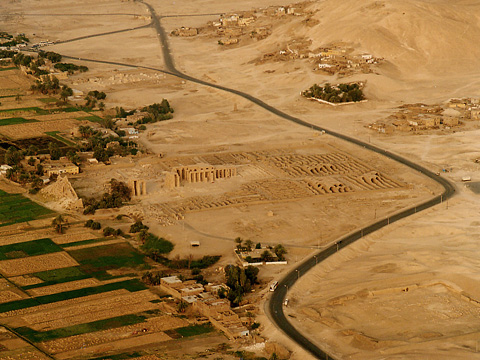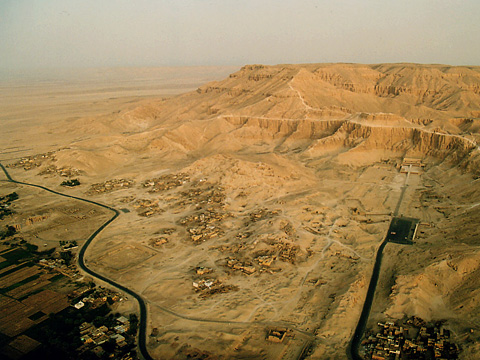The West Bank Temples
On the West Bank of Luxor there are more than thirty known sites of temples, most of them built by the rulers of the New Kingdom. They stretch out along the edge of the cultivated area, the extent of the ancient flood plain of the River Nile from beyond Malqata in the south to el-Tarif in the north. Looking at a map of temple sites it would seem that very little of the space at the foot of the Theban Mountain was wasted.
The earliest of the temples on the West Bank belong to kings of Dynasty XI, Mentuhotep Nebhepetre and Mentuhotep Sankhkare, although a temple built by the second Mentuhotep on Thoth Hill was constructed over earlier remains. The majority of the temples of Western Thebes however, were built to honour the cults of the kings of Dynasties XVIII to XX and were known as ‘Houses of Eternity’ or ‘Houses of Millions of Years’. It is commonly thought that these temples were mortuary structures, associated with the burials of the kings and queens. While this may be partly true, the ‘mortuary temples’ also served as cult temples for many of the deities of the period, places where regular festivals were celebrated and where the people would go to petition their gods. Many of them also had extensive administration buildings and associated palaces. The temples’ primary function however, judging by the reliefs on the walls, seems to be to preserve each ruler’s association with the gods for all of eternity, both during their lifetime and after death.

In order to make the locations clear I have described in most detail those temples which have visible remains and are easily accessible to visitors. There are several modern settlements along the road running south to north which are used to divide the monument area into separate locations for tombs and temples. Beginning with the Temple of Rameses III at Medinet Habu at the southern end of the Theban necropolis in a village called Kom Lolla, the sequence follows the main road along the West Bank running to the north. The next settlement is Qurnet Murai, on a hill just north of the Antiquities Inspectorate where the ticket office is located and where the road forks west towards Deir el-Medina and the Valley of the Queens. Carrying on northwards we come to Sheikh ‘Abd el-Qurna and the Temple of Rameses II (the Ramesseum). A little further along the road are the areas of el-Khokha and Asasif and the Temple of Hatshepsut at Deir el-Bahri. The village at the northern end of the road is known as Dra ‘Abu el-Naga, before the bend where the road forks west to the Valley of the Kings and east to el-Tarif. Just past this junction towards el-Tarif is the Qurna Temple of Seti I.

Between the two areas of Kom Lolla and el-Tarif there are many temple sites. Some, such as Hatshepsut’s temple at Deir el-Bahri and the Temple of Rameses II (the Ramesseum), are huge structures which are well-known to visitors. Other temples are less well-known, with scant remains and may sometimes be little more than a few scattered granite or sandstone blocks half-hidden in piles of sand and debris. Where there is little or nothing to be seen except for the very keen enthusiast, I have listed these temples under the heading of ‘Destroyed Temples’. Some of the kings dismantled the monuments of their ancestors in order to re-use the stone blocks, often overcarving the original names and many blocks can be seen in the temples which obviously came from elsewhere. Probably the best example of this can be seen in the Temple of Merenptah which has recently been restored as an open-air museum. Many of the blocks for this king’s structure came from the dismantled temple of Amenhotep III which stretches from the Colossi of Memnon back to the bend in the road by the ticket office.
There are a few other small temples on the West Bank, mostly dating to Roman times, which were dedicated to various deities. These I have listed under the heading of ‘Cult Temples’ and they can be found at Deir el-Shelwit, Qasr el-Aguz, Deir el-Medina and Thoth Hill.
Most visitors will see the large remaining temples, but it is also great fun to walk the extent of the West Bank road searching for other remains. There may not be much to photograph when you find them, but you will have a sense of achievement as well as the ability to visualise just what the necropolis must have looked like in the height of the New Kingdom.
How to get there
To get to the West Bank you can either take a taxi from Luxor which will take the long route across the new Nile bridge, or take the passenger ferry from Luxor Corniche to el-Gezira. The ferry crosses the river constantly during the day. You can also cross the river by private motor boat. There are always taxis waiting at the ferry terminal to take visitors around the monuments. There is also the ‘arabaya’ or local bus service which will drop you off anywhere on the circuit. Bicycles can be hired in Luxor or at el-Gezira. Tickets must be purchased at the ticket office (the ‘taftish’ is around 5 kilometres from the ferry, just past the Colossi of Memnon) before going to the monuments.
